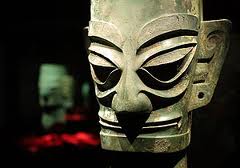The Ancient Chinese Culture of Sanxingdui…
 Via the magic that is Google Chrome, I finally got round to watching the recent Andrew Graham Dixon programmes in which he assesses the history of Chinese Art.
Via the magic that is Google Chrome, I finally got round to watching the recent Andrew Graham Dixon programmes in which he assesses the history of Chinese Art.
As with all of AGD’s art history shows, it was a rather mannered affair, full of confidently expounded theories and ideas, which when his subject is European or Western Art that he’s studied his whole life and in which his expertise lie, is fair enough. I’m generally happy to listen to what he has to say, cringing at some of his tenuous or rather laboured connections perhaps, but enjoying his obvious passion and bowing to his undoubted knowledge.
But I have to admit that I struggled with him on these programmes. The subject is obviously hugely diverse and richly fascinating, but I couldn’t help but get the impression that AGD is very new to the subject and was mostly winging it or relying heavily on more authentic Chinese art historians that were just off screen, diligently writing his script and helping him with pronunciation… Was there not a Chinese expert who could have guided us through their countries rich heritage?
Whatever… One aspect that has stuck with me from the first show however, was that of the amazing Sanxingdui culture…
Since the discovery in 1987, when workman uncovered two pits containing a large number of damaged bronze, jade and gold artifacts in Sichuan Province, Central China, theories around the finds have rapidly developed to the point that many academics contend that they are more important than the Terracotta warriors..
 Radio carbon dated to around 4000 years old, the seemingly discarded pieces were painstakingly reassembled over an eight year period to reveal a series of masks and heads that are striking in their appearance. Rumors of a mysterious and ancient tribe known as the Shu (translated as eye) people had abounded in the area for centuries, but it wasn’t until this discovery that any explanation could be given to the stories.
Radio carbon dated to around 4000 years old, the seemingly discarded pieces were painstakingly reassembled over an eight year period to reveal a series of masks and heads that are striking in their appearance. Rumors of a mysterious and ancient tribe known as the Shu (translated as eye) people had abounded in the area for centuries, but it wasn’t until this discovery that any explanation could be given to the stories.
These beautiful masks with their protruding eyes, “enigmatic smiles” and stylised ears are like nothing else in China’s rich cultural history. They offer the first evidence of a Chinese figurative sculptural art (other than straight forward copies of soldiers in terracotta), a style that was thought until this discovery, to have never been part of the Chinese artistic language.
Its always interesting to compare timelines across cultures. 4000 years ago in the British Isles we were making simple stone carvings such as the Westray Wifey, whilst in Egypt the Naqada People were carving simple animal shapes. I think we can agree that the early Chinese cultures were well ahead of the curve in terms of technique.
Nearly 2000 objects were removed from the pits and these truly amazing works are now on display in a purpose built museum near the discovery site. No idea how easy it would be to visit, but it certainly looks like it would be worth it if you ever find yourself in the Sichuan Basin…
One final thought if you’ve got this far. As soon as I saw them, these figures reminded me of the fairly recent additions to Gaudi’s Sagrada Familia in Barcelona… It’s the emphasis on the eyes…
-
March 23, 2016 at 10:19Homepage





